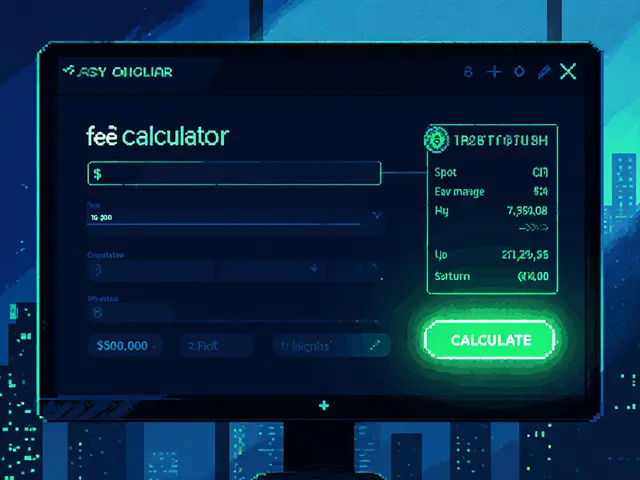Risk Management Tool Scorer
| Platform | Score |
|---|---|
| Enter your preferences and click "Calculate Scores" | |
When you hear the phrase Risk Management Tools and Calculators are software platforms that help organizations spot, evaluate, and mitigate operational, financial, and cybersecurity threats in real time, you’re looking at the digital backbone of modern resilience. Companies that ignore these platforms today end up scrambling during audits, cyber‑incidents, or sudden supply‑chain hiccups. Below is a no‑fluff guide that shows what the leading solutions do, how they differ, and which one fits your team’s workflow.
TL;DR - Quick Takeaways
- Risk management tools now bundle AI‑driven prediction, no‑code workflow builders, and dollar‑based risk quantification.
- LogicGate shines for finance‑focused risk quantification; Sprinto excels at compliance automation.
- OneTrust offers the widest privacy‑and‑regulation suite, while RiskOptics targets strategic operational risk.
- Implementation timelines range from 2weeks (no‑code) to 12weeks (deep integration).
- Use the checklist at the end to score any platform against your must‑haves.
Why modern risk tools matter more than ever
Regulators have tightened reporting rules, cyber attacks now strike every 39 seconds, and supply networks span five continents. Because risk is no longer confined to a single department, silos break down - finance talks to IT, compliance chats with operations, and everyone expects a single source of truth. Traditional spreadsheets can’t keep up with the speed of data ingestion, nor can they translate a “high probability” label into a $‑impact figure that CEOs understand. That’s why today’s platforms embed AI, real‑time dashboards, and automated remediation pathways.
Core features to hunt for
- AI‑powered risk prediction: machine‑learning models that spot emerging threats before they hit.
- Financial quantification: MonteCarlo simulations, OpenFAIR® calculations, or custom dollar‑impact formulas.
- No‑code workflow builder: drag‑and‑drop risk registers that non‑technical users can own.
- Integrated compliance mapping: automatic linking of risks to standards like ISO27001, GDPR, or SOX.
- Real‑time collaboration: web‑native UI with mobile access, role‑based permissions, and comment threads.
- Exportable analytics: native connectors to BI tools (PowerBI, Tableau) or CSV/Excel feeds.
Leading platforms in 2025
LogicGate Risk Cloud
LogicGate Risk Cloud is a no‑code GRC platform that lets you build visual risk workflows without a developer. Its standout feature, Risk Cloud Quantify®, runs MonteCarlo simulations using the OpenFAIR® methodology to turn cyber risk into a clear dollar range. The platform’s graph‑database architecture ties assets, controls, and policies together, giving you a holistic view of how a single vulnerability ripples through the enterprise.
- Implementation: 2‑4weeks for a basic instance; 6‑8weeks for advanced custom apps.
- Pricing: custom component‑based model; no free trial, direct contact required.
- Best for: finance teams that need to speak risk in dollars, and organizations that want to avoid heavy IT involvement.
Sprinto
Sprinto is a cloud‑native compliance automation suite that consolidates risk data, generates AI‑driven recommendations, and maps every risk to its relevant regulatory control. The built‑in risk library covers over 600 standard threats, and the platform pushes corrective actions automatically when a risk exceeds its criticality threshold.
- Implementation: 3‑6weeks, thanks to ready‑made data migration templates.
- Pricing: subscription‑based, free trial available.
- Best for: companies that juggle multiple standards (GDPR, SOC2, ISO27001) and want a single dashboard.
RiskOptics
RiskOptics (formerly Reciprocity) delivers an enterprise‑grade risk‑calculation engine that supports custom formulas, workflow automation, and enterprise‑wide monitoring. While it doesn’t offer a free tier, its strength lies in strategic operational risk modeling that aligns with board‑level KPIs.
- Implementation: 4‑8weeks, typically handled by internal risk officers.
- Pricing: contact sales; no public pricing.
- Best for: large enterprises that need deep custom calculations and a strategic risk‑to‑performance bridge.
OneTrust
OneTrust is a privacy‑focused GRC platform that also offers incident management, third‑party risk, and data discovery across web, iOS, Android, and Windows. Its risk‑based audit module uses AI to prioritize findings, and the third‑party risk exchange connects you with vetted vendors.
- Implementation: 3‑6weeks; 14‑day free trial plus limited free tools.
- Pricing: tiered subscription; detailed quote on request.
- Best for: organizations with heavy data‑privacy obligations (EU, California, Brazil).
Calibrer RM (MicroFocus)
Calibrer RM is a risk‑management add‑on for Micro Focus’s requirement‑tracking suite, linking risk items directly to project requirements. It produces risk matrices, severity charts, and tracks mitigation progress alongside requirement status.
- Implementation: 6‑12weeks, due to integration with existing ALM tools.
- Pricing: license‑based, available through Micro Focus sales channel.
- Best for: software development teams that need risk visibility baked into their requirements lifecycle.
DevSpec (TechExcel)
DevSpec is a lightweight risk‑and‑requirement manager that enables real‑time collaboration on risk registers within software projects. Its visual risk matrix updates instantly as team members adjust likelihood or impact values.
- Implementation: 6‑10weeks, typically managed by the project office.
- Pricing: subscription per user; free trial of 30days.
- Best for: agile squads that want a simple, integrated risk view without heavy GRC overhead.

Side‑by‑side comparison
| Platform | AI Prediction | Financial Quantification | No‑code Builder | Compliance Mapping | Free Trial / Tier |
|---|---|---|---|---|---|
| LogicGate Risk Cloud | Yes (Spark AI) | MonteCarlo + OpenFAIR | Drag‑and‑drop visual apps | Manual mapping, integrations available | None (contact sales) |
| Sprinto | Yes (risk‑recommendation engine) | Basic dollar impact (customizable) | Template‑based workflows | Auto‑maps to 40+ standards | Free trial 14days |
| RiskOptics | Yes (custom ML models) | Fully custom formulas | Low‑code, script‑driven | Manual, via API | None |
| OneTrust | Yes (privacy risk scoring) | Impact scoring (currency optional) | Low‑code policy builder | Extensive built‑in mappings | Free tier + 14‑day trial |
| Calibrer RM | No | Impact matrix (no dollars) | Embedded in Micro Focus suite | Requirement‑linked only | License only |
| DevSpec | No | Impact matrix (no dollars) | Simple UI, no code needed | None (focus on projects) | 30‑day free trial |
How to pick the right tool for your organization
Start with a quick self‑audit. Ask yourself:
- Do I need financial risk numbers that C‑suite executives can act on?
- Am I juggling more than three regulatory frameworks?
- Is my IT team over‑committed, meaning I need a no‑code, quick‑deploy solution?
- Do I require deep integration with existing ALM or ERP systems?
- What’s my budget ceiling for the first 12months?
Score each platform against those criteria using the checklist below. A total above 80% usually signals a good fit.
Scoring checklist
| Criterion | Weight | LogicGate | Sprinto | RiskOptics | OneTrust | Calibrer RM | DevSpec |
|---|---|---|---|---|---|---|---|
| Financial quantification | 25 | 10 | 4 | 3 | 2 | 0 | 0 |
| Compliance automation | 20 | 4 | 10 | 3 | 10 | 0 | 0 |
| No‑code deployment | 15 | 10 | 6 | 5 | 5 | 0 | 8 |
| Integration depth | 15 | 8 | 6 | 9 | 7 | 10 | 6 |
| AI‑driven insights | 15 | 9 | 8 | 9 | 8 | 0 | 0 |
| Pricing transparency | 10 | 2 | 8 | 2 | 8 | 4 | 6 |
Take the weighted scores, add them up, and compare. If two platforms land in the same range, let your team test the free trial (if available) and see which UI feels more natural.
Implementation tips to avoid common pitfalls
- Map data sources early. Connect asset inventories, control libraries, and incident logs before you spin up the workflow builder. Missing data creates blank risk rows that later stall reporting.
- Start with a pilot. Pick a single business unit (e.g., finance) and run the platform for 30days. Use the pilot to refine likelihood scales and impact categories.
- Assign a risk champion. A non‑technical owner who can approve risk scores and push corrective tasks speeds up adoption.
- Leverage AI explanations. When the tool flags a high‑impact risk, ask the built‑in AI for the underlying data points. It helps your team trust the model.
- Automate remediation triggers. Tie a “risk exceeds threshold” event to an automated ticket in ServiceNow or Jira. Closed‑loop workflows reduce manual effort.
Future‑proofing your risk stack
2025 is just the start. Vendors are racing to add natural‑language processing that can ingest audit reports and surface hidden threats. Expect tighter integration with cloud‑security posture management (CSPM) tools, so your risk dashboard can pull vulnerability scores directly from AWS GuardDuty or Azure Defender. When you choose a platform, verify it offers open APIs and a marketplace of add‑ons - that flexibility will protect your investment as new regulations (e.g., AI Act) appear.
Frequently Asked Questions
What is the difference between a risk calculator and a full GRC platform?
A risk calculator focuses on quantifying a single risk - often using formulas or MonteCarlo simulations. A GRC (governance, risk, compliance) platform bundles calculators, workflow automation, policy management, and compliance mapping in one place, letting you track risks from identification to remediation.
Do I need AI if I’m a small business?
AI adds value by surfacing trends you might miss, but many small firms get by with rule‑based alerts. If budget is tight, start with a platform offering a free AI‑lite tier (like Sprinto) and upgrade when you scale.
Can I integrate risk tools with existing ticketing systems?
Yes. Most modern risk platforms expose REST APIs or built‑in connectors for ServiceNow, Jira, and Microsoft Teams. Check the vendor’s integration catalog before signing.
How accurate are MonteCarlo simulations for financial risk?
MonteCarlo provides a range of outcomes based on probability distributions. Accuracy depends on the quality of input data (likelihood, impact severity) and the number of iterations. In practice, it gives executives a confidence interval that’s far more useful than a single point estimate.
Is there a free version of any of these tools?
OneTrust offers limited free tools and a 14‑day trial; Sprinto has a free trial; DevSpec provides a 30‑day trial. LogicGate and RiskOptics do not have a public free tier - you need to request a demo.

Next steps you can take today
1. Draft a one‑page risk‑needs summary for your leadership.
2. Map the five criteria above to your top three vendors.
3. Sign up for any free trial that matches your budget and run a 2‑week pilot.
4. Use the scoring checklist to pick a winner and start the implementation plan.
With the right tool, you’ll move from “we hope we’re covered” to “we know exactly where the money‑impact risk sits and how to fix it”.







VICKIE MALBRUE
February 15, 2025 AT 03:56You’ve got this!
Waynne Kilian
February 16, 2025 AT 21:53Reading through the comparison makes me think about how risk feels a bit like a puzzle we all share – each piece fitting together to reveal a bigger picture. The tools you listed each bring a different colour to the canvas, and that diversity can only help us grow together. I’d suggst giving a quick look at how each platform handles integrations, because that’s often where the real work happens, not just the shiny UI.
Naomi Snelling
February 18, 2025 AT 15:50It’s worth noting that many of these “AI‑driven insights” rely on data harvested from third‑party services, and we don’t always know who’s watching that data. Keep an eye on the privacy policies – they can be a window for hidden surveillance.
Michael Wilkinson
February 20, 2025 AT 09:46Stay focused on the core criteria you need; adding extra bells and whistles can dilute the real risk picture.
Billy Krzemien
February 22, 2025 AT 03:43Great rundown! For teams just getting started, I recommend piloting a platform with a small scope-perhaps the finance department-then expanding once you’ve refined the risk taxonomy.
april harper
February 23, 2025 AT 21:40In the grand theatre of corporate survival, risk tools are the silent protagonists, whispering warnings while the audience remains blissfully unaware.
Clint Barnett
February 25, 2025 AT 15:36The landscape of risk management software has evolved dramatically over the past decade, moving from static spreadsheets to dynamic, AI‑enhanced ecosystems.
The shift is not merely a technological upgrade; it reflects a deeper cultural change toward data‑driven decision making.
When evaluating platforms, one should first ask how the solution ingests and normalizes disparate data sources, because data silos are the Achilles' heel of many risk programs.
Next, consider the granularity of the risk scoring engine – does it allow custom weightings, Monte Carlo simulations, or only predefined scales?
A platform that offers Monte Carlo simulations, like LogicGate, can translate uncertainty into confidence intervals, which executives love to cite in boardrooms.
Integration depth is another decisive factor; if your ERP, ticketing, and cloud‑security tools can push data via APIs, you’ll spend less time on manual entry.
Moreover, the no‑code workflow builder is a powerful democratizer, enabling business analysts to craft risk registers without calling the IT helpdesk.
However, beware of platforms that promise “all‑in‑one” but hide complex licensing tiers behind a seemingly simple UI.
Transparency in pricing not only eases budgeting but also uncovers potential hidden costs for add‑on modules later on.
From a compliance perspective, Sprinto’s auto‑mapping to hundreds of standards can accelerate audit readiness, but it may lack the flexibility needed for niche industry regulations.
OneTrust shines for privacy obligations, yet its breadth can overwhelm smaller teams that crave a focused solution.
For development‑centric organizations, Calibrer RM or DevSpec embed risk directly into the requirements lifecycle, fostering a shift‑left mentality.
Whatever your choice, a phased rollout-starting with a pilot, gathering feedback, and iterating-reduces the risk of project failure.
Finally, embed a feedback loop where risk owners can comment on the relevance of identified threats, creating a living risk register.
In sum, the right tool aligns with your organization’s maturity, budget, and strategic priorities, turning risk from a reactive afterthought into a proactive asset.
Jacob Anderson
February 27, 2025 AT 09:33Oh great, another “AI‑driven” gizmo that will magically predict the next breach while we all sip coffee.
Kate Nicholls
March 1, 2025 AT 03:30The comparison does a solid job of outlining features, but it could benefit from a clearer pricing matrix to help decision‑makers weigh total cost of ownership.
Carl Robertson
March 2, 2025 AT 21:26Watching the risk tools battle it out feels like a chess match where each move reshapes the board, and the true winner is the organization that can anticipate the opponent’s next strike.
Rajini N
March 4, 2025 AT 15:23Pro tip: before committing, export a sample data set from your current system and run it through the trial version to see how the platform handles real‑world inputs.
Sidharth Praveen
March 6, 2025 AT 09:20Keep exploring, you’ll find the perfect fit that makes risk feel like a strategic advantage rather than a burden.
Sophie Sturdevant
March 8, 2025 AT 03:16Leverage the robust risk quantification engine and continuous monitoring capabilities to achieve a holistic GRC posture that aligns with enterprise‑level KPIs.
emmanuel omari
March 9, 2025 AT 21:13Most vendors forget to mention that the underlying data model determines the scalability; if the schema isn’t normalized, you’ll hit performance bottlenecks as data volumes grow.
Andy Cox
March 11, 2025 AT 15:10Nice list looks solid enough for a quick check
Courtney Winq-Microblading
March 13, 2025 AT 09:06When we think about risk, we’re really confronting uncertainty, and these tools give us a language to talk about what scares us and how we can protect each other.
katie littlewood
March 15, 2025 AT 03:03It’s refreshing to see a guide that balances technical depth with practical advice, and I’d add that the human factor often outweighs the software itself. Engaging stakeholders early, fostering a culture of transparency, and celebrating small wins can turn risk management into a shared journey rather than a compliance checkpoint. By aligning the tool’s capabilities with your organization’s values, you’ll not only meet regulatory demands but also unlock new opportunities for innovation and resilience.
Jenae Lawler
March 16, 2025 AT 21:00While the article presents an admirable overview, one might argue that the emphasis on AI undermines the timeless value of expert judgment, which cannot be fully replicated by algorithms.
Chad Fraser
March 18, 2025 AT 14:56Let’s dive in, test those free trials, and turn risk into our competitive edge – the future belongs to the proactive!